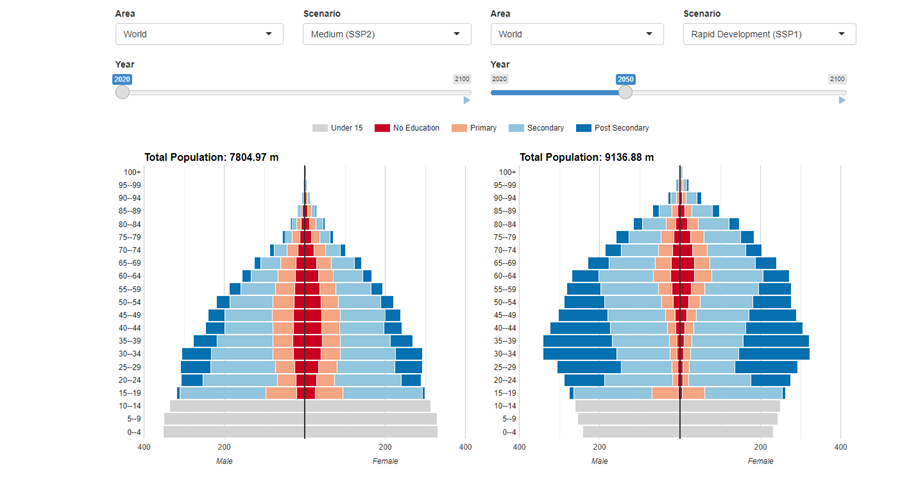
New projections of population and human capital provide insights into what our future could look like all the way until the year 2100 under different developmental scenarios. The findings are presented in datasets compiled by IIASA scientists in partnership with the Wittgenstein Centre for Demography and Global Human Capital.
The Shared Socioeconomic Pathways (SSP) framework is a crucial toolkit for exploring projections of the future state of socioeconomic development and its relationship with climate change, which is widely embraced by the global scientific community. One part of these projections is the population and human capital component of the SSPs — it’s “human core”. It focuses on building future estimates of what the populations of different countries would look like in terms of size, age, levels of educational attainment, sex ratio, life expectancy, migration trends, and other characteristics.
The first set of population and human capital projections following the SSPs was developed in 2013 (WIC2013) and was last updated in 2018 (WIC2018). In 2021, the SSP community requested another update of the human core of the SSPs, which culminated in the recent launch of an updated version, referred to as WIC2023. This updated version provides data, projection assumptions, and results on the populations of 200 countries and regions by age, sex, and education for alternative scenarios from 2020 to 2100, based on seven different future scenarios.
The updated WIC2023 population projection data is available in a new version of the Wittgenstein Centre Human Capital Data Explorer (WCDE). Although the tool is primarily targeted at scientists and policymakers, its simple interface and ease of use make it a go-to solution for anyone interested in learning more about the future of our society. The tool was developed by researchers in the IIASA Population and Just Societies (POPJUS) Program in partnership with the Wittgenstein Centre for Demography and Global Human Capital, a collaborative center of the Austrian Academy of Sciences (Vienna Institute of Demography), IIASA, and the University of Vienna. The projections are also available through the Zenodo data repository.
The most important refinements introduced cover the disparities between individuals with varying levels of education with regard to mortality. This data is now country- and region-specific rather than being normalized to a single level by gender. In addition, education-specific migration rates are implemented in the projection model for the first time. Education-specific fertility levels have also been updated with new estimates.
The overview of the updates introduced as part of WIC2023 is documented in a recent working paper by POPJUS researchers. The paper presents a comparison between the methodology used for developing the global population and education projections under the five SSPs in this update and the previous versions. Furthermore, a brief analysis of the primary results regarding population size and composition was conducted, with comparisons made to earlier projections and other organizations, including the United Nations Population Division.
Key findings
Compared to the previous assumptions, WIC2023 highlights that the world population would peak later and at a higher level of total population. In the most likely scenario from today’s perspective, the world population would peak in 2080 at 10.13 billion and slowly decline after that to reach 9.88 billion in 2100. The main reasons for a later peak and a higher population at the end of the century lie in further reductions in mortality and slower anticipated fertility decline in high-fertility countries.
WIC2018 showed peak population being reached in 2070 at 9.7 billion, with the world population at the end of the century at 9.3 billion. WIC2013 again projected lower population growth, peaking at 9.4 billion in 2070 and declining to 8.9 billion by 2100.
On average the population in the projections will be much better educated than today’s, because the younger cohorts are better educated than the older ones virtually everywhere.
By 2050, the majority of the population would have an upper-secondary education or more (64%) according to the SSP2 scenario and 29% a post-secondary education. Africa would still be the least educated world region, with 30% of the 25+ population having not completed a primary education (13% at the world level) but diminishing from 48% in 2020 (21% at the world level).
News

22 July 2024
Are sustainable aviation fuels truly sustainable?

17 July 2024
Forests endure as carbon sink despite regional pressures

16 July 2024



